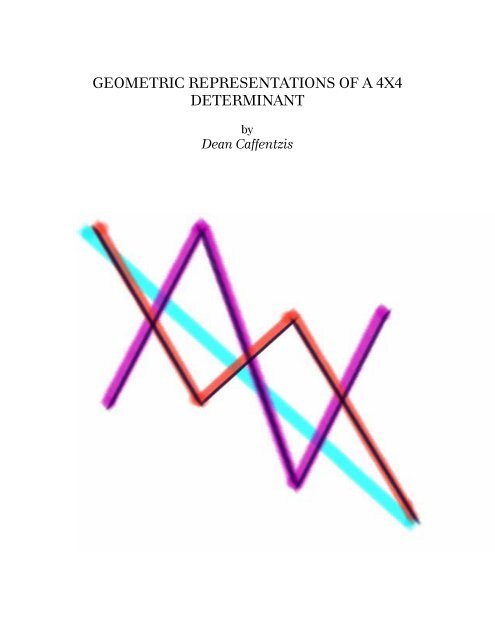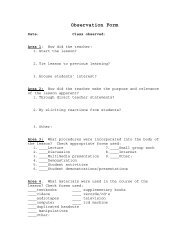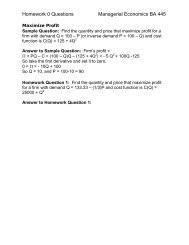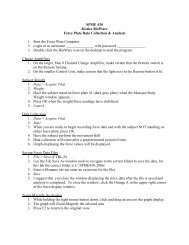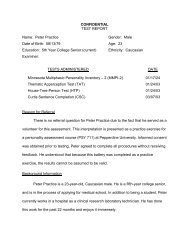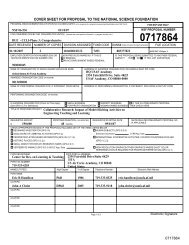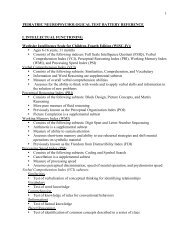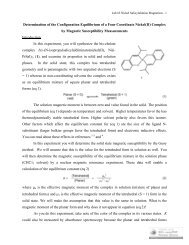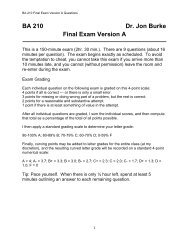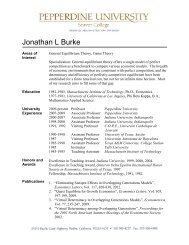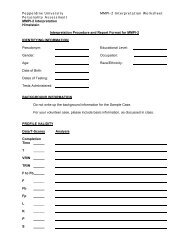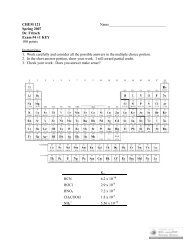geometric representations of a 4x4 determinant - Meet the Faculty
geometric representations of a 4x4 determinant - Meet the Faculty
geometric representations of a 4x4 determinant - Meet the Faculty
You also want an ePaper? Increase the reach of your titles
YUMPU automatically turns print PDFs into web optimized ePapers that Google loves.
GEOMETRIC REPRESENTATIONS OF A 4X4<br />
DETERMINANT<br />
by<br />
Dean Caffentzis
EXPANSION OF A THIRD ORDER<br />
DETERMINANT<br />
THROUGH EXPANSION BY DIAGONALS<br />
Given <strong>the</strong> 3x3 matrix a b c<br />
d e f<br />
g h i<br />
copy columns 1 and 2 and add as columns 4 and 5 so<br />
form <strong>the</strong> 6 3-tuple terms <strong>of</strong> <strong>the</strong> <strong>determinant</strong> by<br />
expansion:<br />
aei + bfg + cdh (from left to right) and <strong>the</strong>n –bdi –<br />
afh –ceg (from right to left)<br />
A different approach is to evaluate <strong>the</strong> n! 3-tuple<br />
terms <strong>of</strong> <strong>the</strong> <strong>determinant</strong> which are found about <strong>the</strong>ir<br />
respective diagonal <strong>determinant</strong> terms. This is done<br />
using 2 maps <strong>of</strong> <strong>the</strong> 3x3 matrix,<br />
a b c<br />
d e f<br />
g h i, as follows…
Step 1: Find <strong>the</strong> <strong>determinant</strong> <strong>of</strong> <strong>the</strong> 3x3 through c<strong>of</strong>actor<br />
expansion; here we expand along <strong>the</strong> 1 st column, so that for:<br />
a b c<br />
d e f<br />
g h i (figure 1)<br />
<strong>the</strong> <strong>determinant</strong> is, a(ei-fh) – d(bi-ch) + g(bf –ce) =<br />
aei – afh – dbi + dch + gbf – gce<br />
Step 2: We observe that for each term <strong>of</strong> <strong>the</strong> <strong>determinant</strong>:<br />
aei, -afh, -dbi, dch, gbf, -gce, each i,j are represented uniquely for<br />
all aij in <strong>the</strong> set S <strong>of</strong> a 3x3 <strong>determinant</strong>, where aij may also be<br />
represented as:<br />
11 12 13<br />
21 22 23<br />
31 32 33 (figure 2)<br />
Step 3: The n! terms <strong>of</strong> 3-tuples are mapped (as an overlay)<br />
according to those terms that have similar patterns. For example,<br />
figure 1 above is overlayed with those <strong>determinant</strong> terms<br />
which are positive represented graphically as:<br />
<strong>the</strong> negative are overlayed onto figure 1 as:<br />
We verify using figure 2 and according to <strong>the</strong> above graphs that for each term <strong>of</strong> <strong>the</strong><br />
<strong>determinant</strong>, that no 2 elements belong to <strong>the</strong> same row or column.
COFACTOR EXPANSION OF A FOURTH<br />
ORDER DETERMINANT<br />
a b c d<br />
e f g h<br />
i j k l<br />
m n o p (figure 3)<br />
Step 1: expanding along <strong>the</strong> 1 st column yields,<br />
a[( f(kp-lo) - j(gp-oh) + n(gl-kh)]<br />
-e[( b(kp-lo) - j(cp-od) + n(cl-kd)]<br />
+i[( b(gp-ho) - f(cp-od) + n(ch-gd)]<br />
-m[( b(gl-hk) - f(cl-dk) + j(ch-gd)]<br />
Step 2: when combining, <strong>the</strong> 24 terms, based on<br />
figure 3, are,<br />
+afkp - aflo - ajgp + ajho + angl - ankh<br />
-ebkp + eblo + ejcp - ejod - encl + enkd<br />
+ibgp - ibho - ifcp + ifod + inch - ingd<br />
-mbgl + mbhk + mfcl- mfdk- mjch + mjgd (figure 4)<br />
Step 3: Start <strong>the</strong> overlay process <strong>of</strong> mapping <strong>the</strong> 24<br />
<strong>determinant</strong> terms <strong>of</strong> figure 4 onto <strong>the</strong> matrix<br />
representation <strong>of</strong> figure 3.
Step 4: By using <strong>the</strong> same pattern that were mapped<br />
in <strong>the</strong> 3x3, we match those terms to that <strong>of</strong><br />
<strong>the</strong> <strong>determinant</strong> map <strong>of</strong> <strong>the</strong> <strong>4x4</strong><br />
+afkp - aflo - ajgp + ajho + angl - ankh<br />
-ebkp + eblo + ejcp - ejod - encl + enkd<br />
+ibgp - ibho - ifcp + ifod + inch - ingd<br />
-mbgl + mbhk + mfcl- mfdk- mjch + mjgd<br />
using <strong>the</strong> patterns <strong>of</strong> <strong>the</strong> 3x3 mappings,<br />
and<br />
we see <strong>the</strong> 1 st two maps <strong>of</strong> <strong>the</strong> <strong>4x4</strong>, maps Ia and Ib as,<br />
color coded here as:<br />
and<br />
+afkp - aflo - ajgp + ajho + angl - ankh<br />
-ebkp + eblo + ejcp - ejod - encl + enkd<br />
+ibgp - ibho - ifcp + ifod + inch - ingd<br />
-mbgl + mbhk + mfcl- mfdk- mjch + mjgd
When applying <strong>the</strong> pattern <strong>of</strong> <strong>the</strong> 3x3 to <strong>the</strong> <strong>4x4</strong> it is<br />
apparent that in <strong>the</strong> 3x3, both maps have 2 triangles and<br />
a diagonal and in <strong>the</strong> <strong>4x4</strong>, maps Ia and Ib have 2<br />
triangles, a diagonal and a rectangular parallelogram.<br />
Since however maps Ia and Ib <strong>of</strong> <strong>the</strong> <strong>4x4</strong> <strong>determinant</strong><br />
only give us 8 out <strong>of</strong> <strong>the</strong> required 24 terms <strong>of</strong> <strong>the</strong><br />
<strong>determinant</strong> we implement a new strategy so that all 24<br />
terms can be represented.<br />
So instead <strong>of</strong> maps Ia and Ib patterned like this,<br />
and<br />
<strong>the</strong> elements <strong>of</strong> each term are connected with line segments through a<br />
diagonal (ei<strong>the</strong>r <strong>the</strong> main diagonal, a lesser diagonal, or at a point ).<br />
and<br />
+afkp - aflo - ajgp + ajho + angl - ankh<br />
-ebkp + eblo + ejcp - ejod - encl + enkd<br />
+ibgp - ibho - ifcp + ifod + inch - ingd<br />
-mbgl + mbhk + mfcl- mfdk- mjch + mjgd
We continue our mapping strategy by overlaying <strong>the</strong><br />
<strong>4x4</strong> represented by a b c d<br />
e f g h<br />
i j k l<br />
m n o p (figure 3) for map II as,<br />
+afkp - aflo - ajgp + ajho + angl - ankh<br />
-ebkp + eblo + ejcp - ejod - encl + enkd<br />
+ibgp - ibho - ifcp + ifod + inch - ingd<br />
-mbgl + mbhk + mfcl- mfdk- mjch + mjgd<br />
and for map III as,<br />
+afkp - aflo - ajgp + ajho + angl - ankh<br />
-ebkp + eblo + ejcp - ejod - encl + enkd<br />
+ibgp - ibho - ifcp + ifod + inch - ingd<br />
-mbgl + mbhk + mfcl- mfdk- mjch + mjgd
The overlay <strong>of</strong> <strong>determinant</strong> terms for map IVa<br />
appears as,<br />
+afkp - aflo - ajgp + ajho + angl - ankh<br />
-ebkp + eblo + ejcp - ejod - encl + enkd<br />
+ibgp - ibho - ifcp + ifod + inch - ingd<br />
-mbgl + mbhk + mfcl- mfdk- mjch + mjgd<br />
while <strong>the</strong> overlay <strong>of</strong> <strong>determinant</strong> terms for map IVb<br />
look like,<br />
+afkp - aflo - ajgp + ajho + angl - ankh<br />
-ebkp + eblo + ejcp - ejod - encl + enkd<br />
+ibgp - ibho - ifcp + ifod + inch - ingd<br />
-mbgl + mbhk + mfcl- mfdk- mjch + mjgd
The final overlay pattern <strong>of</strong> <strong>determinant</strong> terms in<br />
map V is displayed graphically as 2 square<br />
parallelograms,<br />
+afkp - aflo - ajgp + ajho + angl - ankh<br />
-ebkp + eblo + ejcp - ejod - encl + enkd<br />
+ibgp - ibho - ifcp + ifod + inch - ingd<br />
-mbgl + mbhk + mfcl- mfdk- mjch + mjgd<br />
We confirm that all <strong>the</strong> <strong>determinant</strong> terms <strong>of</strong> our<br />
<strong>4x4</strong> have been accounted for in maps Ia, Ib, II,<br />
III, IVa, IVb, and V by combining our color<br />
coded guide shown here as follows:<br />
+afkp - aflo - ajgp + ajho + angl - ankh<br />
-ebkp + eblo + ejcp - ejod - encl + enkd<br />
+ibgp - ibho - ifcp + ifod + inch - ingd<br />
-mbgl + mbhk + mfcl- mfdk- mjch + mjgd
det λI-A/=<br />
(λ-a) b c d<br />
e (λ-f) g h<br />
i j (λ-k) l<br />
m n o (λ-p)<br />
Map Ia: mjgd-(λ-f)ci(λ-p)-h(λ-k)*<br />
n(λ-a)+ebol<br />
Map Ib: (λ-a)(λ-f)(λ-k)(λ-p)-bglm<br />
-dejo+chin<br />
Map II: [(λ-a)(λ-f)ol]-[(λ-k)(λ-p)eb]<br />
-chjm-dgin<br />
Map III:[(λ-a)(λ-p)gj]-[(λ-f)(λ-k)md]<br />
Map IVa:[(λ-a)joh]+[m(λ-f)cl]+<br />
[(λ-p)gbi]+[d(λ-k)ne]<br />
Map IVb:[(λ-a)gln]+[m(λ-k)hb]+<br />
[(λ-p)jec]+[d(λ-f)io]<br />
Map V: -clne–bohi
map III (complement map <strong>of</strong> map V)
The second complement <strong>of</strong> map V is an automorphism <strong>of</strong><br />
<strong>the</strong> subset <strong>of</strong> elements in map III similar in construction to<br />
equations y = x and y = -x in R2 or as rotations <strong>of</strong> <strong>the</strong> xy<br />
axes.
If diag,{a,f,k,p=0}, <strong>the</strong>n<br />
0 b c d<br />
e 0 g h<br />
i j 0 l<br />
m n o 0<br />
Map Ia: dgjm + beol<br />
Map Ib: -bglm –ejod +chin<br />
Map II: -chjm -ingd<br />
Map V: -cenl – bioh<br />
Total nonzero terms det A = 9;<br />
zeros = 15.
det λI-A/=<br />
λ b c 0<br />
e (λ-f) g<br />
i j (λ-k)<br />
h<br />
l<br />
0 n o λ<br />
Map Ia: -i(λ-f)cλ - λnh(λ-k) + beol<br />
Map Ib: λ²[(λ-f)(λ-k)] + chin<br />
Map II: -λ(λ-f)ol - λ(λ-k)eb<br />
Map III: λ²jg<br />
Map IVa: λjoh + λgbi<br />
Map IVb: λgln + λjec<br />
Map V: -bioh – cenl<br />
Characteristic equation <strong>of</strong> <strong>the</strong> zero corner group matrix:<br />
= λ²[(λ-f)( λ-k)+jg] + cn(hi-el) + bo(el-hi)<br />
- λ[(λ-f)ol+(λ-k)eb - joh - gbi - gln - iec]<br />
- λ[ci(λ-f)+nh(λ-k)]<br />
= λ²[(λ-f)( λ-k)+jg] + cn(hi-el) + bo(el-hi)<br />
- λ[((λ-f)(ol+ci))- λ((λ-k)(eb+nh)) - joh - gbi -<br />
gln – iec]
A second automorphism, here onto a subset <strong>of</strong> map V,<br />
where isomorphism F(β) is onto isomorphism F(α) where<br />
α,β are that part <strong>of</strong> <strong>the</strong> solution space <strong>of</strong> <strong>the</strong> characteristic<br />
equation <strong>of</strong> <strong>the</strong> “zero corner group” matrix. The geometry<br />
represented is intersecting lines at <strong>the</strong> origin.<br />
It is easily verified that for that portion <strong>of</strong> <strong>the</strong> remainder <strong>of</strong><br />
<strong>the</strong> solution space <strong>of</strong> <strong>the</strong> “zero corner group matrix”, <strong>the</strong><br />
terms “oh” and ”eb” can be traced on both maps where <strong>the</strong><br />
terms, ”ci” and ”nh” cannot be traced or mapped without<br />
separating out o<strong>the</strong>r elements.
APPROXIMATION METHODS<br />
AND PATTERNS OF CONVERGENCE<br />
Maps V and III also viewed as a convergence onto <strong>the</strong><br />
diagonal using composite maps <strong>of</strong> <strong>determinant</strong> terms.<br />
View <strong>the</strong> Darboux Integral (where Upper and Lower<br />
approaches to a curve or line) that parallel <strong>the</strong> sequence<br />
<strong>of</strong> processes that obtain an upper triangular or lower<br />
triangular square matrix in <strong>the</strong> finite case establishing<br />
those n x n forms as <strong>determinant</strong> functions.
Special Thanks to:<br />
My wife Carole and to my family and to<br />
Pr<strong>of</strong>essor Judy Frasier, St. Petersburg<br />
College for meeting with me.<br />
Biography: Dean Caffentzis, BA, Queens College, Flushing, NY<br />
1984, Florida Insurance Licenses; 220,216.


